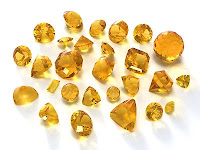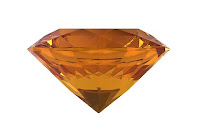APPEARANCE OF CITRINE
Citrine is a variety of quartz that ranges from pale yellow to reddish brown in color. The yellow color, which differentiates Citrine from other quartz varieties such as Amethyst or Smokey Quartz, is due to traces of iron and silicon dioxide within the crystalline structure. Natural Citrine actually is quite rare and is more often created when Amethyst formations near natural heat sources in the Earth’s crust are heated beyond about 900 degrees Fahrenheit. At this point the Amethyst turns yellow or reddish brown becoming Citrine. Interestingly, Citrine may be returned to a purple color by applying beta radiation to it, and sometimes Citrine exhibits both colors, at which point it is referred to as Ametrine. These processes were originally discovered in the middle of the 18th century, but were quickly perfected resulting in a boom on Citrine in Europe. These days only a trained specialist can recognize these “burnt stones”.
HISTORY OF THE CITRINE
Because it is so rarely found in nature, there is very little mythology related to Citrine. However, because of its resemblance to Topaz, it’s alleged miraculous powers very closely match those of Topaz as well. In ancient times, Citrine was worn to protect from snake venom. It was also believed to aid with digestive problems, stomach ailments, and circulation and improve mental focus and physical endurance. Ancient Romans used Citrine in intaglio designs as well as in their jewelry making. And in these times it was also believed that keeping a Citrine crystal in one’s cashbox helped one maintain his wealth.
The name Citrine is derived from the old French word for lemon, “citron”, while darker colored Citrine crystals are named Madeira because of their color’s resemblance to Madeira wine.
MODERN USES OF CITRINE
Nowadays, most Citrine comes from Brazil, Russia,  Spain, France and Hungary, and has become very plentiful, and therefore very affordable. As a result, jewelry makers are using bigger cuts of Citrine in their jewelry and budget minded jewelry buyers really can’t do better for their money.
Spain, France and Hungary, and has become very plentiful, and therefore very affordable. As a result, jewelry makers are using bigger cuts of Citrine in their jewelry and budget minded jewelry buyers really can’t do better for their money.
Bearing a Mohs’ Hardness rating of 7, Citrine is quite insensitive to scratches. And with a crystalline structure almost impervious to cleavage, Citrine therefore also makes a good choice for everyday jewelry.
Citrine is the birthstone for the month of November and is also used to celebrate the thirteenth wedding anniversary, and as an alternate for the eleventh wedding anniversary. If your birthday is in the month of November, consider giving your Mom a gold Mother’s ring for Mothers Day with a warm, mellow Citrine stone.
***If you’ve enjoyed this article, please link back to us at:
https://blackhillsgoldblog.com/?p=954
Read the original article here: Citrine – November’s Birthstone
